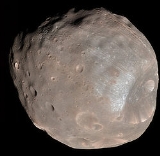
Mars' natural satellites
Encyclopedia
Mars
has two small moons
, Phobos
and Deimos
, which are thought to be captured asteroid
s. Both satellites were discovered in 1877 by Asaph Hall
, and are named after the characters Phobos
(panic/fear) and Deimos
(terror/dread) who, in Greek mythology
, accompanied their father Ares
, god of war, into battle. Ares was known as Mars to the Romans
.
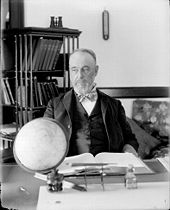 The discovery of the two moons of Mars, Phobos
The discovery of the two moons of Mars, Phobos
and Deimos
, occurred in 1877 when American astronomer Asaph Hall
identified them after a long search, although their existence had been a source of speculation before.
(1571–1630) even predicted their number correctly, although with faulty logic: he wrote that since Jupiter had four known moons and Earth had one, it was only natural that Mars should have two.
Perhaps inspired by Kepler (and quoting Kepler's third law
), Jonathan Swift
's satire Gulliver's Travels
(1726) refers to two moons in Part 3, Chapter 3 (the "Voyage to Laputa
"), in which the astronomers of Laputa are described as having discovered two satellites of Mars orbiting at distances of 3 and 5 Martian diameters, and periods of 10 and 21.5 hours, respectively. The actual orbital distances and periods of Phobos and Deimos of 1.4 and 3.5 Martian diameters, and 7.6 and 30.3 hours, respectively. The orbital periods are roughly similar to those guessed by Swift, but the radii were too big by about a factor of two.
Voltaire
's 1750 short story Micromégas
, about an alien visitor to Earth, also refers to two moons of Mars. Voltaire was presumably influenced by Swift. In recognition of these 'predictions', two craters on Deimos are named Swift and Voltaire.
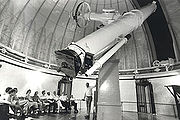 Hall discovered Deimos on August 12, 1877 at about 07:48 UTC
Hall discovered Deimos on August 12, 1877 at about 07:48 UTC
and Phobos on August 18, 1877, at the US Naval Observatory in Washington, D.C.
, at about 09:14 GMT (contemporary sources, using the pre-1925 astronomical convention that began the day at noon, give the time of discovery as August 11, 14:40 and August 17 16:06 Washington mean time
respectively). At the time, he was deliberately searching for Martian moons. Hall had previously seen what appeared to be a Martian moon on August 10, but due to bad weather, he could not definitively identify them until later.
Hall recorded his discovery of Phobos in his notebook as follows:
The names, originally spelled Phobus and Deimus, respectively, were suggested by Henry Madan (1838–1901), Science Master of Eton
, from Book XV of the Iliad
, where Ares
summons Fear and Fright.
perpetrated a celebrated April Fool's hoax in the April edition of the Great Plains Observer, claiming that "Dr. Arthur Hayall of the University of the Sierras reports that the moons of Mars are actually artificial satellites". Both Dr. Hayall and the University of the Sierras were fictitious. The hoax gained worldwide attention when Houston's claim was repeated, apparently in earnest, by a Soviet scientist, Iosif Shklovsky
.
and David C. Jewitt
surveyed the Hill sphere
of Mars for irregular satellites. [The] search covered nearly the entire Hill sphere, but scattered light from Mars excluded the inner few arcminutes where the satellites Phobos and Deimos reside. No new satellites were found to an apparent limiting red magnitude of 23.5, which corresponds to radii of about 0.09 km using an albedo of 0.07.
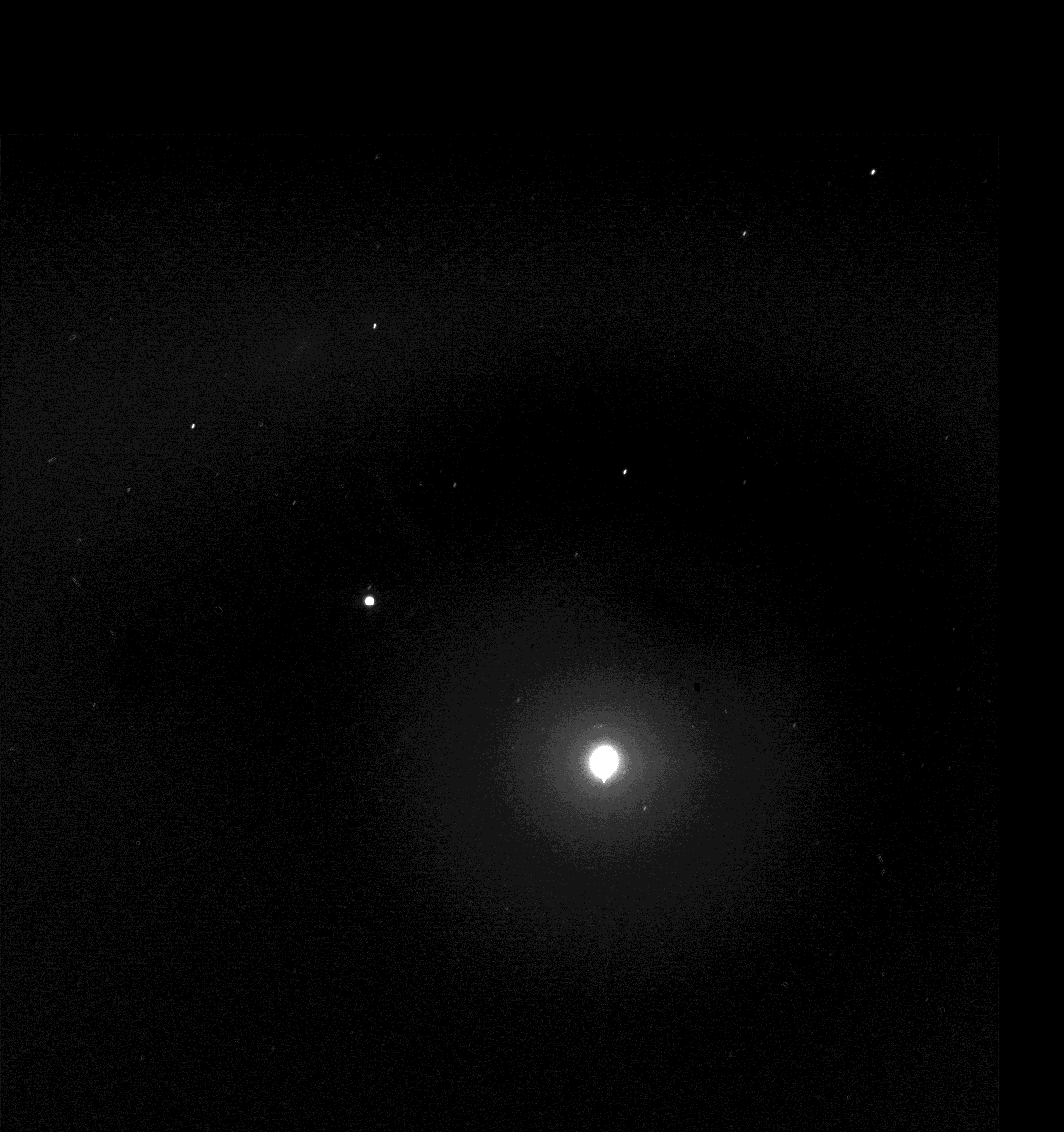 If viewed from the surface of Mars near its equator, full Phobos looks about one third as big as the Earth's full moon from Earth. It has an angular diameter
If viewed from the surface of Mars near its equator, full Phobos looks about one third as big as the Earth's full moon from Earth. It has an angular diameter
of between 8' (rising) and 12' (overhead). It would look smaller when the observer is further away from the Martian equator, and is completely invisible (always beyond the horizon) from Mars' polar ice caps. Deimos looks more like a bright star or planet for an observer on Mars, only slightly bigger than Venus
looks from Earth; it has an angular diameter of about 2'. The Sun's angular diameter as seen from Mars, by contrast, is about 21'. Thus there are no total solar eclipse
s on Mars, as the moons are far too small to completely cover the Sun. On the other hand, total lunar eclipse
s of Phobos are very common, happening almost every night. See also Transit of Phobos from Mars
and Transit of Deimos from Mars
for eclipse-like events.
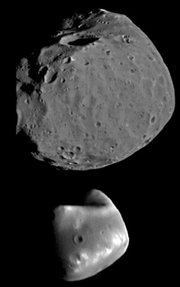 The motions of Phobos and Deimos would appear very different from that of our own Moon. Speedy Phobos rises in the west, sets in the east, and rises again in just eleven hours, while Deimos, being only just outside synchronous orbit, rises as expected in the east but very slowly. Despite its 30 hour orbit, it takes 2.7 days to set in the west as it slowly falls behind the rotation of Mars, and has long again to rise.
The motions of Phobos and Deimos would appear very different from that of our own Moon. Speedy Phobos rises in the west, sets in the east, and rises again in just eleven hours, while Deimos, being only just outside synchronous orbit, rises as expected in the east but very slowly. Despite its 30 hour orbit, it takes 2.7 days to set in the west as it slowly falls behind the rotation of Mars, and has long again to rise.
Both moons are tidally locked
, always presenting the same face towards Mars. Since Phobos orbits Mars faster than the planet itself rotates, tidal forces are slowly but steadily decreasing its orbital radius. At some point in the future, when it approaches Mars closely enough (see Roche limit
), Phobos will be broken up by these tidal forces. Several strings of craters on the Martian surface, inclined further from the equator the older they are, suggest that there may have been other small moons that suffered the fate expected of Phobos, and also that the Martian crust as a whole shifted between these events. Deimos, on the other hand, is far enough away that its orbit is being slowly boosted instead, as in the case of our own Moon.
s, with spectra
, albedo
, and density
very similar to those of C- or D-type asteroids. Based on their similarity, one hypothesis is that both moons may be captured main-belt asteroids. Both moons have very circular orbits which lie almost exactly in Mars's equatorial plane, and hence a capture origin requires a mechanism for circularizing the initially highly eccentric orbit, and adjusting its inclination into the equatorial plane, most probably by a combination of atmospheric drag and tidal force
s, although it is not clear that sufficient time is available for this to occur for Deimos. Capture also requires dissipation of energy. The current Mars atmosphere is too thin to capture a Phobos-sized object by atmospheric braking. Geoffrey Landis has pointed out that the capture could have occurred if the original body was a binary asteroid
that separated under tidal forces.
Phobos could be a second-generation Solar System object that coalesced
in orbit after Mars formed, rather than forming concurrently out of the same birth cloud as Mars.
 Another hypothesis is that Mars was once surrounded by many Phobos- and Deimos-sized bodies, perhaps ejected into orbit around it by a collision with a large planetesimal
Another hypothesis is that Mars was once surrounded by many Phobos- and Deimos-sized bodies, perhaps ejected into orbit around it by a collision with a large planetesimal
. The high porosity of the interior of Phobos (based on the density of 1.88 g/cm3, voids are estimated to comprise 25 to 35 percent of Phobos' volume) is inconsistent with an asteroidal origin. Observations of Phobos in the thermal infrared suggest a composition containing mainly phyllosilicates, which are well known from the surface of Mars. The spectra are distinct from those of all classes of chondrite
meteorites, again pointing away from an asteroidal origin. Both sets of findings support an origin of Phobos from material ejected by an impact on Mars that reaccreted in Martian orbit, similar to the prevailing theory
for the origin of Earth's moon.
Mars
Mars is the fourth planet from the Sun in the Solar System. The planet is named after the Roman god of war, Mars. It is often described as the "Red Planet", as the iron oxide prevalent on its surface gives it a reddish appearance...
has two small moons
Natural satellite
A natural satellite or moon is a celestial body that orbits a planet or smaller body, which is called its primary. The two terms are used synonymously for non-artificial satellites of planets, of dwarf planets, and of minor planets....
, Phobos
Phobos (moon)
Phobos is the larger and closer of the two natural satellites of Mars. Both moons were discovered in 1877. With a mean radius of , Phobos is 7.24 times as massive as Deimos...
and Deimos
Deimos (moon)
Deimos is the smaller and outer of Mars's two moons . It is named after Deimos, a figure representing dread in Greek Mythology. Its systematic designation is '.-Discovery:Deimos was discovered by Asaph Hall, Sr...
, which are thought to be captured asteroid
Asteroid
Asteroids are a class of small Solar System bodies in orbit around the Sun. They have also been called planetoids, especially the larger ones...
s. Both satellites were discovered in 1877 by Asaph Hall
Asaph Hall
Asaph Hall III was an American astronomer who is most famous for having discovered the moons of Mars in 1877...
, and are named after the characters Phobos
Phobos (mythology)
Phobos is the personification of horror in Greek mythology. He is the offspring of Ares and Aphrodite. He was known for accompanying Ares into battle along with his brother, Deimos, the goddess Enyo, and his father’s attendants. Timor is his Roman equivalent...
(panic/fear) and Deimos
Deimos (mythology)
In Greek mythology, Deimos was the personification of terror.He was the son of Ares and Aphrodite. He is the twin brother of Phobos and the goddess Enyo who accompanied Ares into battle, as well as his father's attendants, Trembling, Fear, Dread, and Panic...
(terror/dread) who, in Greek mythology
Greek mythology
Greek mythology is the body of myths and legends belonging to the ancient Greeks, concerning their gods and heroes, the nature of the world, and the origins and significance of their own cult and ritual practices. They were a part of religion in ancient Greece...
, accompanied their father Ares
Ares
Ares is the Greek god of war. He is one of the Twelve Olympians, and the son of Zeus and Hera. In Greek literature, he often represents the physical or violent aspect of war, in contrast to the armored Athena, whose functions as a goddess of intelligence include military strategy and...
, god of war, into battle. Ares was known as Mars to the Romans
Ancient Rome
Ancient Rome was a thriving civilization that grew on the Italian Peninsula as early as the 8th century BC. Located along the Mediterranean Sea and centered on the city of Rome, it expanded to one of the largest empires in the ancient world....
.
History

Phobos (moon)
Phobos is the larger and closer of the two natural satellites of Mars. Both moons were discovered in 1877. With a mean radius of , Phobos is 7.24 times as massive as Deimos...
and Deimos
Deimos (moon)
Deimos is the smaller and outer of Mars's two moons . It is named after Deimos, a figure representing dread in Greek Mythology. Its systematic designation is '.-Discovery:Deimos was discovered by Asaph Hall, Sr...
, occurred in 1877 when American astronomer Asaph Hall
Asaph Hall
Asaph Hall III was an American astronomer who is most famous for having discovered the moons of Mars in 1877...
identified them after a long search, although their existence had been a source of speculation before.
Early speculations
The possibility of Martian moons had been speculated long before Hall's discovery. The astronomer Johannes KeplerJohannes Kepler
Johannes Kepler was a German mathematician, astronomer and astrologer. A key figure in the 17th century scientific revolution, he is best known for his eponymous laws of planetary motion, codified by later astronomers, based on his works Astronomia nova, Harmonices Mundi, and Epitome of Copernican...
(1571–1630) even predicted their number correctly, although with faulty logic: he wrote that since Jupiter had four known moons and Earth had one, it was only natural that Mars should have two.
Perhaps inspired by Kepler (and quoting Kepler's third law
Kepler's laws of planetary motion
In astronomy, Kepler's laws give a description of the motion of planets around the Sun.Kepler's laws are:#The orbit of every planet is an ellipse with the Sun at one of the two foci....
), Jonathan Swift
Jonathan Swift
Jonathan Swift was an Irish satirist, essayist, political pamphleteer , poet and cleric who became Dean of St...
's satire Gulliver's Travels
Gulliver's Travels
Travels into Several Remote Nations of the World, in Four Parts. By Lemuel Gulliver, First a Surgeon, and then a Captain of Several Ships, better known simply as Gulliver's Travels , is a novel by Anglo-Irish writer and clergyman Jonathan Swift that is both a satire on human nature and a parody of...
(1726) refers to two moons in Part 3, Chapter 3 (the "Voyage to Laputa
Laputa
Laputa is a fictional place from the book Gulliver's Travels by Jonathan Swift.Laputa is a fictional flying island or rock, about 4.5 miles in diameter, with an adamantine base, which its inhabitants can maneuver in any direction using magnetic levitation...
"), in which the astronomers of Laputa are described as having discovered two satellites of Mars orbiting at distances of 3 and 5 Martian diameters, and periods of 10 and 21.5 hours, respectively. The actual orbital distances and periods of Phobos and Deimos of 1.4 and 3.5 Martian diameters, and 7.6 and 30.3 hours, respectively. The orbital periods are roughly similar to those guessed by Swift, but the radii were too big by about a factor of two.
Voltaire
Voltaire
François-Marie Arouet , better known by the pen name Voltaire , was a French Enlightenment writer, historian and philosopher famous for his wit and for his advocacy of civil liberties, including freedom of religion, free trade and separation of church and state...
's 1750 short story Micromégas
Micromégas
"Micromégas" is a short story by the French philosopher and satirist Voltaire. It is a significant development in the history of literature because it originates ideas which helped create the genre of science fiction....
, about an alien visitor to Earth, also refers to two moons of Mars. Voltaire was presumably influenced by Swift. In recognition of these 'predictions', two craters on Deimos are named Swift and Voltaire.
Discovery

Coordinated Universal Time
Coordinated Universal Time is the primary time standard by which the world regulates clocks and time. It is one of several closely related successors to Greenwich Mean Time. Computer servers, online services and other entities that rely on having a universally accepted time use UTC for that purpose...
and Phobos on August 18, 1877, at the US Naval Observatory in Washington, D.C.
Washington, D.C.
Washington, D.C., formally the District of Columbia and commonly referred to as Washington, "the District", or simply D.C., is the capital of the United States. On July 16, 1790, the United States Congress approved the creation of a permanent national capital as permitted by the U.S. Constitution....
, at about 09:14 GMT (contemporary sources, using the pre-1925 astronomical convention that began the day at noon, give the time of discovery as August 11, 14:40 and August 17 16:06 Washington mean time
Washington mean time
Washington mean time was the time at the meridian through the center of the old dome atop the main building at the old US Naval Observatory at Washington, D.C. This Washington meridian was defined on 28 September 1850 by the United States Congress...
respectively). At the time, he was deliberately searching for Martian moons. Hall had previously seen what appeared to be a Martian moon on August 10, but due to bad weather, he could not definitively identify them until later.
Hall recorded his discovery of Phobos in his notebook as follows:
The names, originally spelled Phobus and Deimus, respectively, were suggested by Henry Madan (1838–1901), Science Master of Eton
Eton College
Eton College, often referred to simply as Eton, is a British independent school for boys aged 13 to 18. It was founded in 1440 by King Henry VI as "The King's College of Our Lady of Eton besides Wyndsor"....
, from Book XV of the Iliad
Iliad
The Iliad is an epic poem in dactylic hexameters, traditionally attributed to Homer. Set during the Trojan War, the ten-year siege of the city of Troy by a coalition of Greek states, it tells of the battles and events during the weeks of a quarrel between King Agamemnon and the warrior Achilles...
, where Ares
Ares
Ares is the Greek god of war. He is one of the Twelve Olympians, and the son of Zeus and Hera. In Greek literature, he often represents the physical or violent aspect of war, in contrast to the armored Athena, whose functions as a goddess of intelligence include military strategy and...
summons Fear and Fright.
Mars moon hoax
In 1959, Walter Scott HoustonWalter Scott Houston
Walter Scott Houston was an American popularizer of amateur astronomy. He wrote the "Deep-Sky Wonders" column in Sky and Telescope magazine from 1946 to 1993.-Biography:...
perpetrated a celebrated April Fool's hoax in the April edition of the Great Plains Observer, claiming that "Dr. Arthur Hayall of the University of the Sierras reports that the moons of Mars are actually artificial satellites". Both Dr. Hayall and the University of the Sierras were fictitious. The hoax gained worldwide attention when Houston's claim was repeated, apparently in earnest, by a Soviet scientist, Iosif Shklovsky
Iosif Shklovsky
Iosif Samuilovich Shklovsky was a Soviet astronomer and astrophysicist...
.
Recent surveys
Searches have been conducted for additional satellites. Most recently, Scott S. SheppardScott S. Sheppard
Scott S. Sheppard is an astronomer in the Department of Terrestrial Magnetism at the Carnegie Institution for Science. Starting as a graduate student at the Institute for Astronomy at the University of Hawaii, he was credited with the discovery of many small moons of Jupiter, Saturn, Uranus, and...
and David C. Jewitt
David C. Jewitt
David C. Jewitt is a professor of astronomy formerly at the University of Hawaii Institute for Astronomy, now at UCLA. He was born in 1958 in England, and is a 1979 graduate of the University of London. Jewitt received an M.Sc. and a Ph.D. in astronomy at the California Institute of Technology in...
surveyed the Hill sphere
Hill sphere
An astronomical body's Hill sphere is the region in which it dominates the attraction of satellites. To be retained by a planet, a moon must have an orbit that lies within the planet's Hill sphere. That moon would, in turn, have a Hill sphere of its own...
of Mars for irregular satellites. [The] search covered nearly the entire Hill sphere, but scattered light from Mars excluded the inner few arcminutes where the satellites Phobos and Deimos reside. No new satellites were found to an apparent limiting red magnitude of 23.5, which corresponds to radii of about 0.09 km using an albedo of 0.07.
Characteristics

Angular diameter
The angular diameter or apparent size of an object as seen from a given position is the “visual diameter” of the object measured as an angle. In the vision sciences it is called the visual angle. The visual diameter is the diameter of the perspective projection of the object on a plane through its...
of between 8' (rising) and 12' (overhead). It would look smaller when the observer is further away from the Martian equator, and is completely invisible (always beyond the horizon) from Mars' polar ice caps. Deimos looks more like a bright star or planet for an observer on Mars, only slightly bigger than Venus
Venus
Venus is the second planet from the Sun, orbiting it every 224.7 Earth days. The planet is named after Venus, the Roman goddess of love and beauty. After the Moon, it is the brightest natural object in the night sky, reaching an apparent magnitude of −4.6, bright enough to cast shadows...
looks from Earth; it has an angular diameter of about 2'. The Sun's angular diameter as seen from Mars, by contrast, is about 21'. Thus there are no total solar eclipse
Solar eclipse
As seen from the Earth, a solar eclipse occurs when the Moon passes between the Sun and the Earth, and the Moon fully or partially blocks the Sun as viewed from a location on Earth. This can happen only during a new moon, when the Sun and the Moon are in conjunction as seen from Earth. At least...
s on Mars, as the moons are far too small to completely cover the Sun. On the other hand, total lunar eclipse
Lunar eclipse
A lunar eclipse occurs when the Moon passes behind the Earth so that the Earth blocks the Sun's rays from striking the Moon. This can occur only when the Sun, Earth, and Moon are aligned exactly, or very closely so, with the Earth in the middle. Hence, a lunar eclipse can only occur the night of a...
s of Phobos are very common, happening almost every night. See also Transit of Phobos from Mars
Transit of Phobos from Mars
A transit of Phobos across the Sun as seen from Mars takes place when Phobos passes directly between the Sun and a point on the surface of Mars, obscuring a large part of the Sun's disc for an observer on Mars. During a transit, Phobos can be seen from Mars as a large black disc rapidly moving...
and Transit of Deimos from Mars
Transit of Deimos from Mars
A transit of Deimos across the Sun as seen from Mars takes place when Deimos passes directly between the Sun and a point on the surface of Mars, obscuring a small part of the Sun's disc for an observer on Mars...
for eclipse-like events.

Both moons are tidally locked
Tidal locking
Tidal locking occurs when the gravitational gradient makes one side of an astronomical body always face another; for example, the same side of the Earth's Moon always faces the Earth. A tidally locked body takes just as long to rotate around its own axis as it does to revolve around its partner...
, always presenting the same face towards Mars. Since Phobos orbits Mars faster than the planet itself rotates, tidal forces are slowly but steadily decreasing its orbital radius. At some point in the future, when it approaches Mars closely enough (see Roche limit
Roche limit
The Roche limit , sometimes referred to as the Roche radius, is the distance within which a celestial body, held together only by its own gravity, will disintegrate due to a second celestial body's tidal forces exceeding the first body's gravitational self-attraction...
), Phobos will be broken up by these tidal forces. Several strings of craters on the Martian surface, inclined further from the equator the older they are, suggest that there may have been other small moons that suffered the fate expected of Phobos, and also that the Martian crust as a whole shifted between these events. Deimos, on the other hand, is far enough away that its orbit is being slowly boosted instead, as in the case of our own Moon.
Orbital details
| Name and pronunciation | Image | Diameter (km) | Mass (kg) | Semi-major axis (km) |
Orbital period (h) |
Average moonrise period (h, d) |
||
|---|---|---|---|---|---|---|---|---|
| Mars I | Phobos Phobos (moon) Phobos is the larger and closer of the two natural satellites of Mars. Both moons were discovered in 1877. With a mean radius of , Phobos is 7.24 times as massive as Deimos... |
/ˈfoʊbəs/ FOE-bəs |
.jpg) |
22.2 km (27×21.6×18.8) | 1.08 | 9 377 km | 7.66 | 11.12 h (0.463 d) |
| Mars II | Deimos Deimos (moon) Deimos is the smaller and outer of Mars's two moons . It is named after Deimos, a figure representing dread in Greek Mythology. Its systematic designation is '.-Discovery:Deimos was discovered by Asaph Hall, Sr... |
/ˈdaɪməs/ DYE-məs |
 |
12.6 km (10×12×16) | 2 | 23 460 km | 30.35 | 131 h (5.44 d) |
| The relative sizes of and distance between Mars, Phobos, and Deimos, to scale. | ||||||||
Origin
The origin of the Martian moons is still controversial. Phobos and Deimos both have much in common with carbonaceous C-type asteroidC-type asteroid
C-type asteroids are carbonaceous asteroids. They are the most common variety, forming around 75% of known asteroids, and an even higher percentage in the outer part of the asteroid belt beyond 2.7 AU, which is dominated by this asteroid type...
s, with spectra
Electromagnetic spectrum
The electromagnetic spectrum is the range of all possible frequencies of electromagnetic radiation. The "electromagnetic spectrum" of an object is the characteristic distribution of electromagnetic radiation emitted or absorbed by that particular object....
, albedo
Albedo
Albedo , or reflection coefficient, is the diffuse reflectivity or reflecting power of a surface. It is defined as the ratio of reflected radiation from the surface to incident radiation upon it...
, and density
Density
The mass density or density of a material is defined as its mass per unit volume. The symbol most often used for density is ρ . In some cases , density is also defined as its weight per unit volume; although, this quantity is more properly called specific weight...
very similar to those of C- or D-type asteroids. Based on their similarity, one hypothesis is that both moons may be captured main-belt asteroids. Both moons have very circular orbits which lie almost exactly in Mars's equatorial plane, and hence a capture origin requires a mechanism for circularizing the initially highly eccentric orbit, and adjusting its inclination into the equatorial plane, most probably by a combination of atmospheric drag and tidal force
Tidal force
The tidal force is a secondary effect of the force of gravity and is responsible for the tides. It arises because the gravitational force per unit mass exerted on one body by a second body is not constant across its diameter, the side nearest to the second being more attracted by it than the side...
s, although it is not clear that sufficient time is available for this to occur for Deimos. Capture also requires dissipation of energy. The current Mars atmosphere is too thin to capture a Phobos-sized object by atmospheric braking. Geoffrey Landis has pointed out that the capture could have occurred if the original body was a binary asteroid
Binary asteroid
A binary asteroid is a system of two asteroids orbiting their common center of mass, in analogy with binary stars. 243 Ida was the first binary asteroid to be identified when the Galileo spacecraft did a flyby in 1993...
that separated under tidal forces.
Phobos could be a second-generation Solar System object that coalesced
Accretion (astrophysics)
In astrophysics, the term accretion is used for at least two distinct processes.The first and most common is the growth of a massive object by gravitationally attracting more matter, typically gaseous matter in an accretion disc. Accretion discs are common around smaller stars or stellar remnants...
in orbit after Mars formed, rather than forming concurrently out of the same birth cloud as Mars.

Planetesimal
Planetesimals are solid objects thought to exist in protoplanetary disks and in debris disks.A widely accepted theory of planet formation, the so-called planetesimal hypothesis of Viktor Safronov, states that planets form out of cosmic dust grains that collide and stick to form larger and larger...
. The high porosity of the interior of Phobos (based on the density of 1.88 g/cm3, voids are estimated to comprise 25 to 35 percent of Phobos' volume) is inconsistent with an asteroidal origin. Observations of Phobos in the thermal infrared suggest a composition containing mainly phyllosilicates, which are well known from the surface of Mars. The spectra are distinct from those of all classes of chondrite
Chondrite
Chondrites are stony meteorites that have not been modified due to melting or differentiation of the parent body. They formed when various types of dust and small grains that were present in the early solar system accreted to form primitive asteroids...
meteorites, again pointing away from an asteroidal origin. Both sets of findings support an origin of Phobos from material ejected by an impact on Mars that reaccreted in Martian orbit, similar to the prevailing theory
Giant impact hypothesis
The giant impact hypothesis states that the Moon was created out of the debris left over from a collision between the young Earth and a Mars-sized body. The colliding body is sometimes called Theia for the mythical Greek Titan who was the mother of Selene, the goddess of the moon.The giant impact...
for the origin of Earth's moon.

